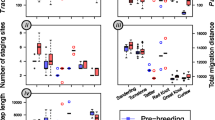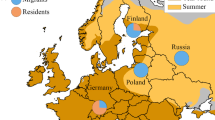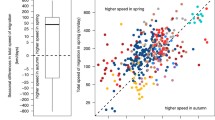Summary
We model the yearly cycle of small migratory birds to explain the variation in scheduling of complete molt, in particular why some birds molt immediately after breeding on the breeding grounds (summer molt) whereas others migrate to their wintering grounds before molt is initiated (winter molt). We employ the method of dynamic programming, because of its suitability for modelling life history traits. Feather quality and latitude entered the model as state variables and were assumed to affect survival rate and reproductive success. Migration and molt were assumed to be associated with increased mortality risks. By changing the parameters in the model we were able to generate most existing molt patterns, including summer and winter molt, biannual (summer and winter) molt, and molt migration. Our model suggests that the scheduling of molt is basically a result of a trade-off between having a high feather quality during breeding versus during the non-breeding period. A high impact of feather quality on survival rate in combination with low costs of molt resulted in biannual molt. Winter molt became more likely as the survival rateper se increased. A low seasonal amplitude in survival rate is a prerequisite for the occurrence of molt migration. Molt duration, migration costs and reproductive successper se were found to have no impact on the timing of molt. We also investigated the effect of benefits from prior occupancy at breeding and winter grounds.
Similar content being viewed by others
References
Alerstam, T. (1990)Bird Migration. Cambridge University Press, Cambridge, UK.
Alerstam, T. and Högstedt, G. (1982) Bird migration and reproduction in relation to habitats for survival and breeding.Ornis Scand. 13, 25–37.
Berthold, P. and Querner, U. (1982) Genetic basis of moult, wing length, and body weight in a migratory bird species,Sylvia atricapilla.Experientia 38, 801–2.
Blomqvist, S. and Elander, M. (1981) Sabine's gull (Xema sabini), Ross's gull (Rhodostethia rosea) and ivory gull (Pagophila eburnea) — gulls in the Arctic: a review.Arctic 34, 122–32 and 388.
Dolnik, V.R. and Gavrilov, V.M. (1979) Bioenergetics of molt in the chaffinch (Fringilla coelebs).Auk 96, 253–64.
Emlen, S.T. (1975) Migration: orientation and navigation. InAvian Biology, Vol. 5 (D.S. Farner and J.R. King, eds) pp. 129–219. Academic Press, New York USA.
Fretwell, S.D. (1985) Why do birds migrate? Inter and intraspecific competition in the evolution of bird migration, contributions from population ecology.Acta Congr. Int. Ornithol. 18, 630–7.
Gauthreaux S.A. Jr. (1982) The ecology and evolution of avian migration systems. InAvian biology, Vol. 6 (D.S. Farner, J.R. King and K.C. Parkes, eds) pp. 93–168. Academic Press, New York, USA.
Ginn, H.B. and Melville, D.S. (1983)Moult in Birds. Guide 19, BTO, Tring, UK.
Glutz von Blotzheim, U.N. and Bauer, K.M. (1991)Handbuch der Vögel Mitteleuropas. Band 12/II. Passeriformes (3. Teil). Aula—Verlag, Wiesbaden, Germany.
Hamilton, W.D. and Zuk, M. (1982) Heritable true fitness and bright birds: a role for parasites?Science 218, 384–7.
Hasselquist, D., Hedenström, A., Lindström, Å. and Bensch, S. (1988) The seasonally divided flight feather moult in the barred warblerSylvia nisoria — a new moult pattern for European passerines.Ornis Scand. 19, 280–6.
Haukioja, E. (1971) Flightlessness in some moulting passerines in Northern Europe.Ornis Fenn. 48, 101–16.
Hedenström, A., Bensch, S., Hasselquist, D., Lockwood, M. and Ottosson, U. (1993) Migration, stopover and moult of the great reed warblerAcrocephalus arundinaceus in Ghana, West Africa.Ibis 135, 177–80.
Hedenström, A. and Møller, A. P. (1992) Morphological adaptations to song flight in passerine birds: a comparative study.Proc. R. Soc. Lond. B247, 183–7.
Hedenström, A. and Pettersson, J. (1987) Migration routes and wintering areas of willow warblersPhylloscopus trochilus (L.) ringed in Fennoscandia.Ornis Fenn. 64, 137–43.
Houston, A., Clark, C., McNamara, J. and Mangel, M. (1988) Dynamic models in behavioural and evolutionary ecology.Nature 332, 29–34.
Hussell, D.J.T. (1972) Factors affecting clutch size in arctic passerines.Ecol. Monogr. 42, 317–64.
Jehl, J.R., Jr. and Murray, B.G., Jr. (1986) The evolution of normal and reversed sexual size dimorphism in shorebirds and other birds.Curr. Ornithol. 3, 1–86.
Jenni, L. and Winkler, R. (1994)Moult and Ageing of European Passerines. Academic Press, London, UK.
Jönsson, P.E. and Alerstam, T. (1990) The adaptive significance of parental role division and sexual size dimorphism in breeding shorebirds.Biol. J. Linn. Soc. 41, 301–14.
Kendeigh, S.C. (1949) Effect of temperature and season on the energy resources of the English sparrow.Auk 66, 113–27.
Ketterson, E.D. and Nolan, V., Jr. (1976) Geographic variation and its climatic correlates in the sex ratio of eastern-wintering dark-eyed juncos (Junco hyemalis).Ecology 57, 679–93.
King, J.R. (1981) Energetics of avian moult.Acta Congr. Int. Ornithol. 17, 312–317.
Lack, D. (1968)Ecological Adaptations for Breeding in Birds. Methuen, London, UK.
Lindström, Å., Visser, G.H. and Daan, S. (1993a) The energetic cost of feather synthesis is proportional to basal metabolic rate.Physiol. Zool. 64, 490–510.
Lindström, Å., Pearson, D.J., Hasselquist, D., Hedenström, A., Bensch, S. and Åkesson, S. (1993b) The moult of barred warblersSylvia nisoria in Kenya — evidence for a split wing-moult pattern initiated during the birds' first winter.Ibis 135, 403–9.
Ludwig, D. and Levin, S.A. (1991) Evolutionary stability of plant communities and the maintenance of multiple dispersal types.Theor. Pop. Biol. 40, 285–307.
Lundberg, S. and Alerstam, T. (1986) Bird migration patterns: conditions for stable geographical population segregation.J. Theor. Biol. 123, 403–14.
Mangel, M. and Clark, C.W. (1988)Dynamic Modelling in Behavioral Ecology. Princeton University Press, Princeton, USA.
Maynard Smith, J. (1982)Evolution and the Theory of Games. Cambridge University Press, Cambridge, UK.
Maynard Smith, J. and Price, G.R. (1973) The logic of animal conflict.Nature 246, 15–18.
Murphy, M.E. and King, J.R. (1990) Diurnal changes in tissue glutathione and protein pools of molting white-crowned sparrows: the influence of photoperiod and feeding schedules.Physiol. Zool. 63, 1118–40.
Murphy, M.E. and King, J.R. (1991) Nutritional aspects of avian moult.Acta Congr. Int. Ornithol. 20, 2186–93.
Myers, J.P. (1981a) Cross-seasonal interactions in the evolution of sandpiper social systems.Behav. Ecol. Sociobiol. 8, 195–202.
Myers, J.P. (1981b) A test of three hypotheses for latitudinal segregation of the sexes in wintering birds.Can. J. Zool. 59, 1527–34.
Noordhuis, R. (1989) Patronen in slagpenrui: oecofysiologische aanpassingen.Limosa 62, 35–45 (in Dutch with English summary).
Norberg, U.M. (1990)Vertebrate Flight. Springer-Verlag, Berlin, Germany.
Payne, R.B. (1972) Mechanisms and control of moult. InAvian Biology, Vol. 2 (D.S. Farner and J.R. King, eds) pp. 103–55. Academic Press, New York, USA.
Pearson, D.J. (1973) Moult of some Palaearctic warblers wintering in Uganda.Bird Study 20, 24–36.
Pennycuick, C.J. (1975) Mechanics of flight. InAvian Biology, Vol. 5 (D.S. Farner and J.R. King, eds) pp. 1–75. Academic Press, New York, USA.
Pennycuick, C.J. (1989)Bird Flight Performance: a Practical Calculation Manual. Oxford University Press, Oxford, UK.
Prys-Jones, R. (1991) The occurrence of biannual primary moult in passerines.Bull. Br. Ornithol. Club 111, 150–2.
Rayner, J.M.V. (1986) Vertebrate flapping flight mechanics and aerodynamics, and the evolution of flight in bats. InBiona report, Vol. 5 (W. Nachtigall, ed.) pp. 27–75. Gustav Fischer, Stuttgart, Germany.
Ricklefs, R.E. (1980) Geographical variation in clutch size among passerine birds: Ashmole's hypothesis.Auk 97, 38–49.
Salomonsen, F. (1968) The moult migration.Wildfowl 19, 5–24.
Stresemann, E. and Stresemann, V. (1966) Die Mauser der Vögel.J. Orn. Sonderheft.
Stresemann, E. (1963) Zeitraum und Verlauf der Handschwingen—Mauser palaearktischer Möwen, Seeschwalben und Limicolen.J. Orn. 104, 424–235.
Svensson, L. (1992)Identification Guide for European Passerines. 4th ed. Lars Svensson, Stockholm, Sweden.
Underhill, L.G., Prys-Jones, R.P., Dowsett, R. J., Herroelen, P., Johnson, D.N., Lawn, M.R., Norman, S.C., Pearson, D.J. and Tree, A.J. (1992) The biannual primary moult of willow warblersPhylloscopus trochilus in Europe and Africa.Ibis 134, 286–97.
von Haartman, L., (1968) The evolution of resident versus migratory habit in birds. Some considerations.Ornis Fenn. 45, 1–7.
Williamson, K. (1968)Identification for Ringers. The Genera Cettia, Locustella, Acrocephalus and Hippolais. BTO, Tring, UK.
Author information
Authors and Affiliations
Rights and permissions
About this article
Cite this article
Holmgren, N., Hedenström, A. The scheduling of molt in migratory birds. Evol Ecol 9, 354–368 (1995). https://doi.org/10.1007/BF01237759
Issue Date:
DOI: https://doi.org/10.1007/BF01237759




